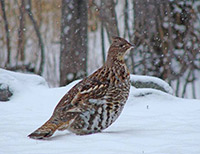Measuring the diets of ruffed grouse living in the Mat-Su Valley
by Kathleen McCoy |
In 1988, the Alaska Department of Fish and Game transplanted 140 ruffed grouse from Interior Alaska to the Matanuska-Susitna (Mat-Su) Valley so that local enthusiasts could hunt them here. The ruffed grouse have established themselves in the region and are harvested by local and visiting recreational hunters.
 The Southcentral chapter of the Ruffed Grouse Society decided they wanted to learn
more about grouse and collected the crops of harvested birds for 10 years. Why the
crops? Like most birds, ruffed grouse store food in their crops - an enlarged out-pocketing
of their esophagus - before passing it on to the stomach for digestion. By saving
the crops they effectively save the stored food that the birds had harvested in its
undigested state for future study.
The Southcentral chapter of the Ruffed Grouse Society decided they wanted to learn
more about grouse and collected the crops of harvested birds for 10 years. Why the
crops? Like most birds, ruffed grouse store food in their crops - an enlarged out-pocketing
of their esophagus - before passing it on to the stomach for digestion. By saving
the crops they effectively save the stored food that the birds had harvested in its
undigested state for future study.
The local members of the Society wanted to know what the ruffed grouse ate in the Mat-Su Valley during fall and winter and whether their diet changed during that period. To do this, they needed a biological scientist with experience in dietary analysis. At their request, Dr. Ian van Tets, a biology professor at UAA, and Josh Bishoff, an environmental science student at APU, took on the task of analyzing the contents of the 88 collected and frozen crops of the grouse that the grouse hunters had harvested between 1999 and 2009.
The analyses were carried out in Dr. van Tets' laboratory in the new ConocoPhillips Integrated Science Building at UAA where Josh painstakingly identified, sorted and weighed the contents of the crops. The subsequent analysis revealed clear dietary trends. The most important elements in the diet were buds and catkins from the quaking aspen. These did not appear in the diet, however, before mid-fall. In early fall, high bush cranberry and rose hips were the major food items. Field horsetail was an important supplementary food item in the winter and willow buds appear to have been taken opportunistically by the birds whenever they were available.
This is the first project on habitat use by this introduced species in Southcentral Alaska and is intended to form the basis for further study. The research has environmental implications that go beyond the feeding habits of the grouse. This species was introduced into Southcentral Alaska so that local enthusiasts could hunt them here. At this point, no one really knows how far the birds will spread in Southcentral Alaska - will they remain within the Mat-Su Valley or will they spread further into, for example, Chugach State Park or Chugach National Forest? It is also unknown if they will affect species that are native to this area such as ptarmigan.
This project was Josh's senior project at APU. He graduates this semester and intends to apply to UAA's M.S. program in spring 2011. If he does so, Dr. van Tets will support Josh's application and is confident that he will be accepted and that the Ruffed Grouse Society will financially support both him and his project at UAA.
 "Measuring the diets of ruffed grouse living in the Mat-Su Valley" is licensed under a Creative Commons Attribution-NonCommercial 4.0 International License.
"Measuring the diets of ruffed grouse living in the Mat-Su Valley" is licensed under a Creative Commons Attribution-NonCommercial 4.0 International License.









